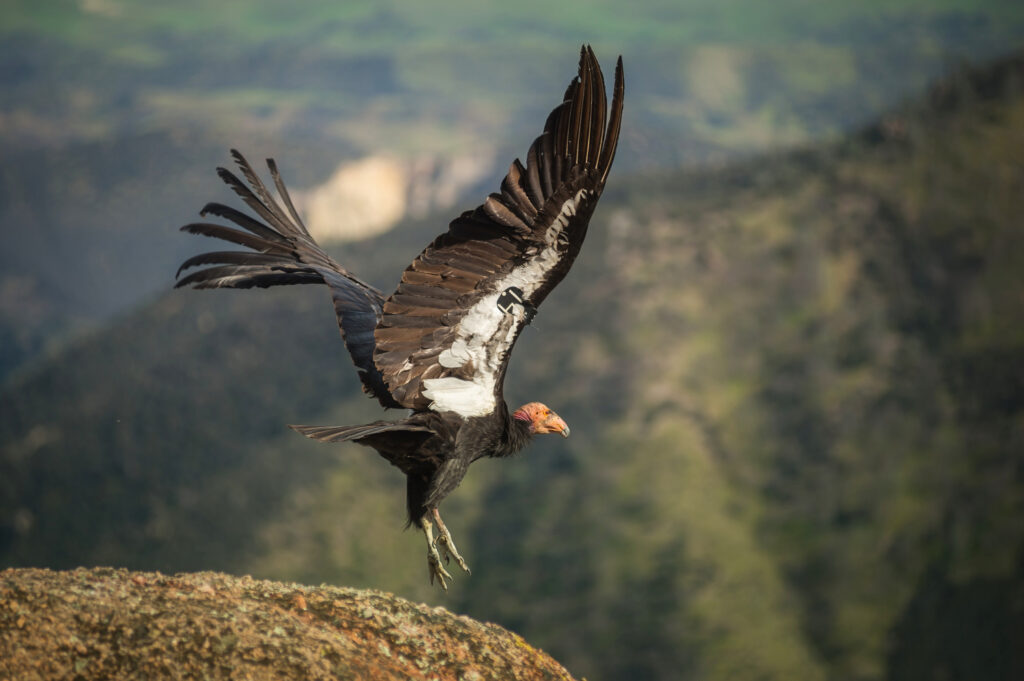
5 Best National Parks to see California Condors plus tips for spotting California Condors
- Jennifer Melroy
- Last Modified August 20, 2022
- First Published on October 4, 2021




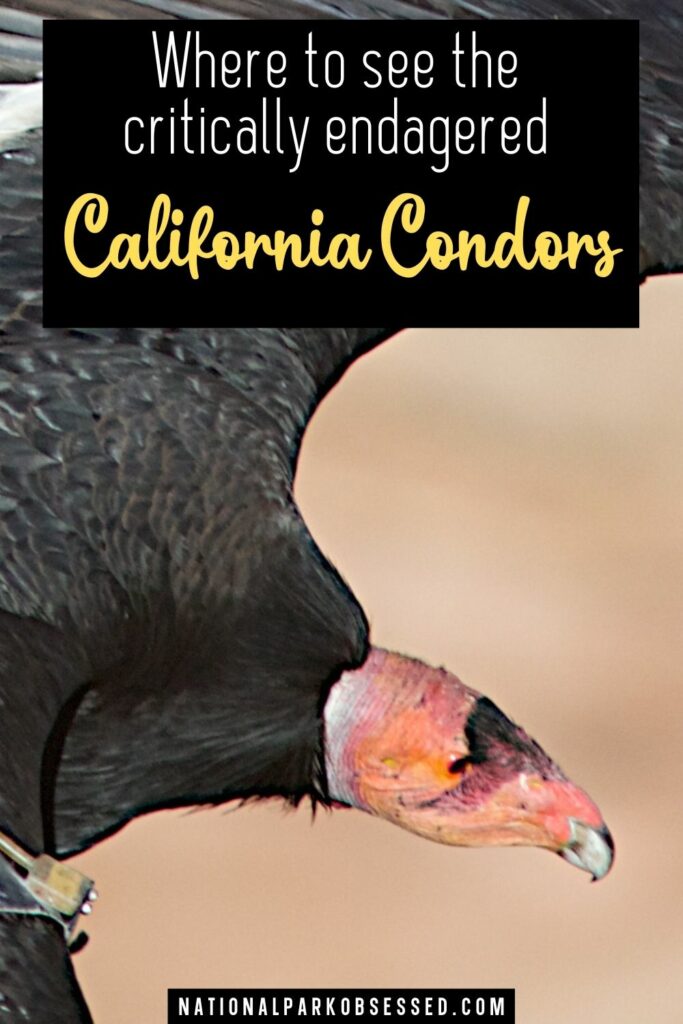


Post Summary: Where to See California Condors
If you spend any time with me in the southwest or southern to mid-California, you might notice that I spend a lot of time watching the skies. I’m always on the lookout for one of my favorite birds. I’ll be the first to admit it’s an ugly bird but I can’t help but smile and be impressed every time I see a California Condor. This massive New World vulture and should be extinct. I shouldn’t be seeing California Condors in the wild and the birds were extinct in the wild 3 years before I was born. California Condors are an amazing story of mankind’s change in environmental awareness.
Today over 300 California Condors flying free in California, Utah, Arizona, and Baja California Mexico. Here are the best national parks to see California Condors.

California Condors Profile
Common Name: California Condor
Scientific Name: Gymnogyps californianus
Life Span in the Wild: Up to 60 years
Body Size: 3.5 to 4.5 ft
Wingspan: Up to 10 ft.
Weight: 15 to 31 lbs
IUNCN Red List Status: Critically Endangered
Current Range: Central/Southern California, Southern Utah, Northern Arizona, and Baja California Mexico.

A Brief History of the California Condors
California Condors are one of the largest flying birds in the world and are the largest bird in North America. At one time, these large birds were found across most of North America. Around 11,000 years ago, North America’s climate changed and the bird’s range was reduced to what is now the Western United States and a little bit of Southwest Canada.
These massive birds are known to have a wingspan upwards of 10 ft. They have a natural lifespan of about 60 years and have been recorded flying at speeds of 56 miles per hour and at heights of up to 15,100 ft. They are social animals and have a complex social structure. Condors are carrion (decaying animal flesh) eaters. They prefer to feed on large mammals such as deer but will eat smaller mammals when available. Condors are semi-mongoumous. As they reach sexual maturity, the condors find a breeding partner, and the breeding pair typically form a lifelong bond.
Due to the Condor’s conservation status, these birds are heavily monitored and DNA testing is done on all chicks. While rare, some birds have to form triads to raise chicks. In 2016, Male #204 and Male #470 formed a triad with #534 to raise chick #842. Male #470 is the father. In 2019, Male #204 and Male #470 formed a triad with #646 and raised #1003. Male #646 is the father of this chick. Since DNA testing each chick, it has been found occasionally females will breed with males outside of their nesting partner.
Indigenous People and the California Condors
California Condors are have influenced the mythology of many of the Indigenous tribes of the region. The California Condor myths see the birds as having both positive and negative roles pending on the tribe. The Wiyot tribe of California views the bird as the creator of mankind after the world had been wiped out by a flood. On the other hand, the Mono view the condor as a destroyer who seized humans and drained their blood. The Yorok people say the condor eats the moon and the winds cause eclipses.
Early archeological desecrations of Native American graves have revealed condor bones and condor feather headdresses. Several California tribes have a Condor Dance these include Chumash, Miwok, and Pomo. I check YouTube and couldn’t locate a North American condor dance but here is one performed by the Sayaka Cultural Group in 2009 while in the United States on a cultural mission to and to see the California condors flying free.
California Condors Extinct in the Wild
As westward expansion happened and more and more people moved west into the homeland of the California Condors, the birds started to face human pressures. The birds were hunted, poisoned, captured as well as having their natural food supply was reduced. By the late 1900s, the Condors were only found in the mountains regions of southern California.
As technology advanced, Condors faced increased threats. In the 1940s, a new “revolutionary” pesticide DDT was introduced to the market and was being as an agricultural insecticide and mosquito control. As the use of DDT increased, it started working its way into the food chain and having an increased environmental impact. As early as 1957, environmentalists were starting to see alarming effects on the environment and animal populations.
Studies throughout the 1960s showcased the impacts of DDT. One major effect was the thinning of eggshells for numerous birds of prey species and other birds such as the California Condors. The thinning of eggshells combined with illegal hunting and human encroachment further reduced the population of California Condors.
By the 1970s there were an estimated 25-35 condors in the wild and conservationists realized that the species was on the brink of extinction. Studies through the 1980s were made to help save the species. Some early efforts were made to remove eggs from the nest and incubate the eggs in Zoo then release the birds. By 1986, those efforts had increased the population to 27 birds but it wasn’t enough. Things were critical and a radically ambitious slightly controversial plan was developed. On April 19, 1987, the California Condor was declared extinct in the wild as the last free-flying condor was captured. At this point, there were 22 California Condors. All living in captivity in Los Angeles Zoo and the San Diego Wild Animal Park.
For the next four years, a captive breeding program worked to increase the number of condors. Condors only produce one egg per nest, but if something happens to the egg, the birds will lay a second egg. This is called double clutch and biologists used this to their advantage and would remove the first egg and hand raise the chick using a condor head puppet.
While increasing the captive population, studies were done using Andean Condors to work on how to reestablish the population. In 1992, three release sites were selected and the first California Condors were reintroduced. In 1996, a site was selected in Arizona and the birds took to the sky. By 1999, there were 161 birds. In 2006, the first documented nest was found.
California Condors Reintroduction and Status Today
The current goal of the California Condors Reintroduction Plan is to have the birds downgraded from critically endangered to threatened and to meet the following goals
- At least two non-captive populations and one captive population – This has been met. There are currently 3 non-captive populations and one captive population
- Each population has at least 150 individuals – This goal has been met by the CA Flock and Captive Breeding population.
- 15 Breeding Pairs – Only the Captive Breeding population meets this goal but the wild flocks are moving towards meeting this goal.
- The population must be self-sustaining. – The wild flock is moving closer to this with each passing year.
As of 2019, there are 518 California Condors. Of those 337 are free-flying. There were 14 confirmed wild-fledged chicks and 32 captive-raised chicks released into the wild. Sadly 17 free-flying birds died. Nine of those are due to lead toxicosis.
The current free-flying populations (as of 2019)
- AZ/UT flock – 98 Individuals
- CA Flock – 200 Individuals
- SoCal Flock – 99 Individuals
- Central CA Flock – 101 Individuals
- Baja Flock – 39 Individuals
While the 2020 population report hasn’t been released, the recovery program suffered some serious setbacks. The 2020 wildfire season killed and injured many birds. At least 11 condors (10% of the Big Sur flock) were killed in the Dolan Fire and the Ventana condor research facility and release site infrastructure were completely destroyed. But even with the losses, several wild-born chicks survived the fires either due to the superbly protected nesting location or by skilled rock climbers climbing down to evacuate them.
Overall, the future of the condor is positive and improving. In 2021, condors will be returning to the traditional Yurok territory and Redwoods National Park with a joint reintroduction effort between the Yurok Tribe, National Park Service, and US Fish and Wildlife Service.
Threats to California Condors Today
The biggest threat to California Condors hasn’t changed it is still humans. At least 65% of all wild California Condor deaths between 1992 and 2019 were directly related to humans. This includes lead toxicosis, powerlines, and shooting.
Studies have shown that most California Condors are exposed to lead by feeding on carcasses of animals shot with lead ammunition. Lead ammunition fragments upon impact and leaves behind tiny fragments. Some of these fragments are left behind by hunters in gut piles and California Condors feed on that gut pile and carcass and ingest lead. As of July 1, 2019, the state of California has banned the use of lead ammunition when taking wildlife with firearms. Hopefully, we will start seeing a reduction of lead toxicosis in the California flock.
Powerlines have always been a problem for large birds. The birds sometimes collide with the powerlines and are killed as a result of the collision. Other times the condors will try to roost the polls or lines and get electrocuted. Captive-bred condors go through an aversion training program in hopes that they will pass this training down to their chick and reduce the number of condor powerline deaths.
A newer threat to the California Condors is the increasing amount of microtrash showing up in the environment. Microtrash refers to small pieces of garbage that are often overlooked such as torn corners candy bar wrappers, shards of glass, gum wrappers, random chunks of plastic, and other such trash. California Condors are curious birds and scavengers and will pick this trash up and can be ingested and get stuck in the gastrointestinal tract and cause impaction. This will result in starvation and death by preventing the birds from digesting food. Zion’s first condor chick along with the 1000th chick born since the start of the recovery program shows a worrying habit of picking up discarded water bottles and flying around with them.

Suggested Reading to Learn More About the California Condor
Condor: To the Brink and Back–the Life and Times of One Giant Bird – Written by John Nielson, environment correspondent for National Public Radio, this book is an in-depth account of the unprecedented herculean effort to save North America’s largest bird. >> Click here to buy this book.
Return of the Condor: The Race To Save Our Largest Bird From Extinction – John Moir has been covering the journey of the California Condors since the start of the recovery program. He shares an insider’s view of the journey to save the species. >> Click here to buy this book.
Condor: Spirt of the Canyon – This is engaging children’s book tells the story of a young Yaqui boy who goes on a magical adventure. This book is written by Robert Mesta is an ornithologist and a member of the Yaqui Tribe of southern Arizona. Mesta. >> Click here to buy this book.
Tips for Spotting California Condors in the Wild
- Ask the rangers at the visitor center for the recent sightings or where the birds are hanging out. It isn’t uncommon for the residential birds to have a favorite hangout. If visiting in the spring, there may be a breeding pair with a nest.
- Bring a pair of binoculars. Binoculars extend your viewing range and allow you to see things that are further away and are more flexible for locating birds. >>> Check out our guide to the best compact binoculars.
- If you see a group of people with spotting scopes out stop and ask what they are looking at. It isn’t uncommon to find a group of birders, sitting around with their spotting scopes at a condor nest, watching the parents come and go. Someone in the group will be happy to help direct you to find the birds with your binoculars and if you are really friendly, you might get to look through someone else’s spotting scope.
- Look for large black birds flying in a circles. They are often observed flying in thermal along cliffs and ridges.
- Always keep an eye to the sky. California Condors can travel up to 150 miles a day so they can be on the move at any time anywhere in their range.
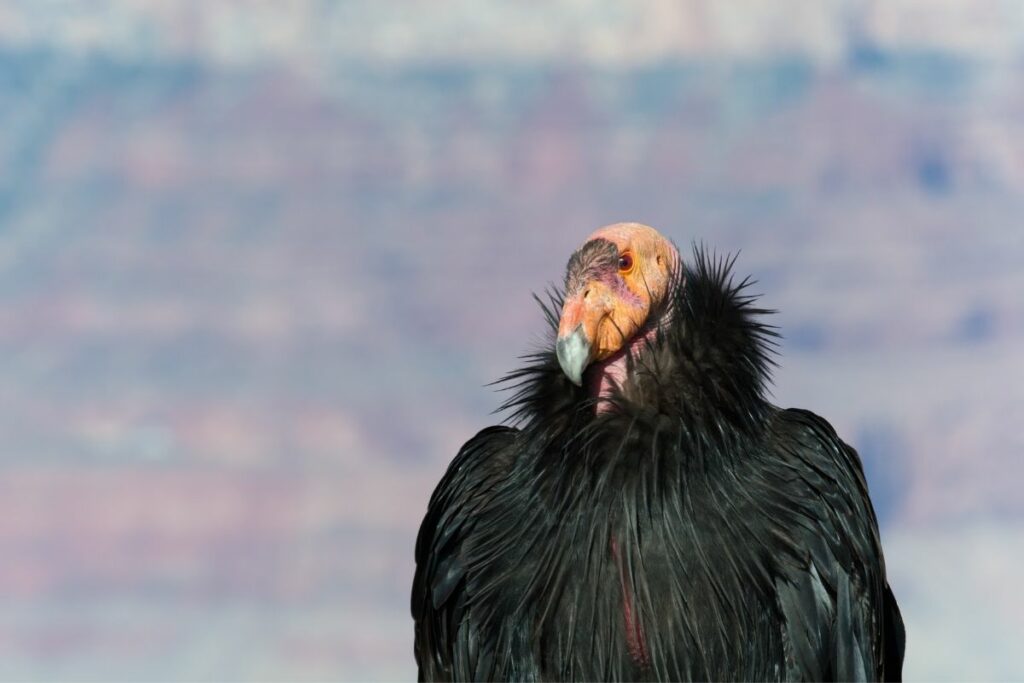
Did I see a Turkey Vulture or California Condor?
Turkey Vultures and California Condors are both New World Vultures and can be a little tricky to tell apart. They are both large black birds with bald heads and white patches on their wings. There are a few key differences
Size of the Bird
California Condors are the largest bird in North America.
Where is the white patch on the underside of the wing?
California Condors have a white triangle on the leading edge of their winds. Juvenile condors will have a sort of mottled gray triangle. Turkey Vultures have white/light gray feathers on the trailing edge of their wings.
How are they holding their winds in flight?
A California Condor is an elegant bird in flight, they hold their wings flat and soar without rocking back and forth. Turkey vultures hold their wings in a V-shape and have an sort of ungainly flight.
What color is the head?
Juvenile birds of both species have a grey/black head but in adult birds, California Condors have vibrant orangish pink heads while turkey vultures have a red heads.
Does it have a wing tag?
If the bird has a colored vinyl tag on either of its wings, it is a California Condor. Almost every free-flying California Condor has a wing tag so birds without tags are likely not a condor but there are several juvenile condors who are currently untagged.
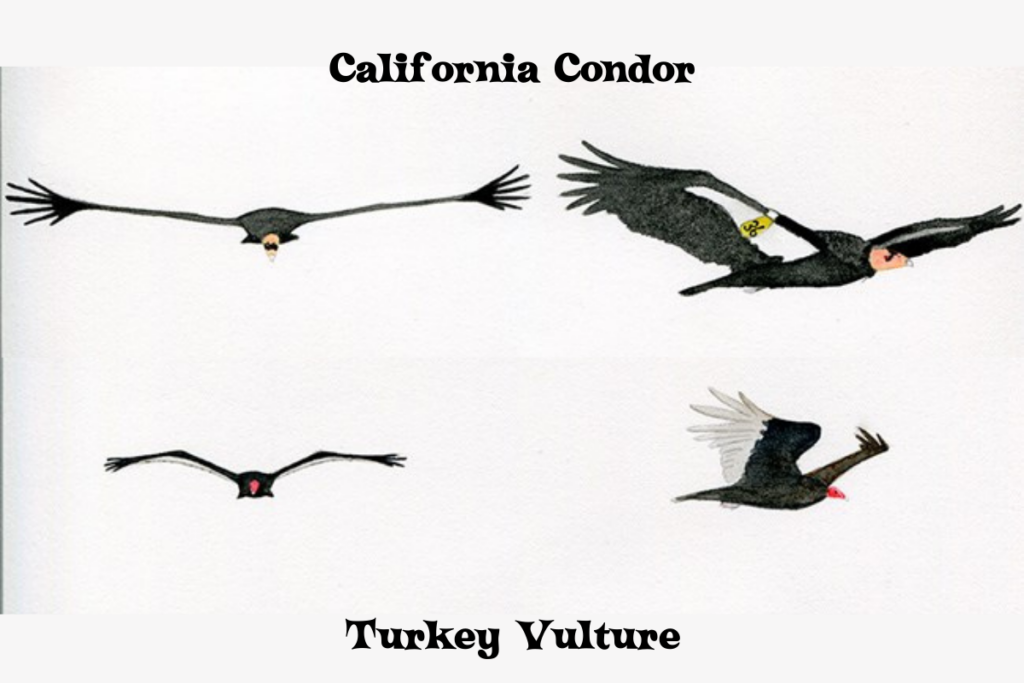
What do the wing tags mean?
Almost every California Condor has a colored vinyl tag on one or both of its wings. These are the birds’ identification tags. Despite 30 years of hard work by the California Condor Recovery Plan, the birds are still critically endangered and the species is highly monitored. These tags allow both researchers and the public to track and report the birds’ movements.
When you see a bird, try to get a good look at the tag. Try to note both the color and the numbers/letters on the tag. When you get home, you can go to Condor Spotter and find locate the bird and find out when and where it was born as well as its paternity and sometimes a link to the bird’s biography (more common for the California Flocks). Please report all condor sights to the land management agency of that area.
When a new California Condor is hatched either in the wild or in one of the captive breeding facilities. It is given a number and entered into the studbook. If it is a wild-hatched bird, it is given a DNA test to establish its paternity as some condors are 100% monogamous and some birds form a triad partnership. The birds are numbered chronologically. So the bigger the number the younger the bird. The numbering started with the 22 birds captured from the wild in 1987. At the time of publication, Condor 1053 is flying free as part of the Utah/Arizona flock.
California Flocks (Southern California and Central California)
Birds in these flocks have colored tags with numbers. Each color represents a series of birds.
- Red – 100s
- Yellow – 200s
- Blue – 300s
- White – 400s
- Black – 500s (select black tags may have symbols in addition to the number, these are older tags)
- Purple – 600s
- Green – 700s
- Pink – 800s
- Tan/Brown – 900s
- Orange – 1000s (100s in SoCal Flock)
Utah/Arizona Flock
All birds in the UT/AZ flock have black tags with various numbers, letters, and symbols.
Baja California Flock
I can’t find any information on how they plan to tag the birds in Baja but the released birds have black tags. These birds are NOT listed on Condor Spotter.
Best National Parks to see California Condors
Pinnacles National Park, California
Pinnacles National Park is located in central California just south of San Jose. This small National Park is the BEST national park for seeing California Condors. This small national park has been a release site for the California Condor since 2003. The park is located at the heart of the Condor’s former range. The park was selected due to its high rocky outcroppings combined with open grasslands for the animals to feed in.
Every year a portion of the captive breed juvenile condors are transferred to the park where they spend at least two months in a flight pen acclimating to life in the wild. California Condors are a social bird so Pinnacles residential birds will stop by and check out the new condors. Once the juveniles are comfortable, they are turned loose to live the rest of their lives in the wild with minimal human interference.
In 2010, Pinnacles hit a major milestone. For the first time since 1889, a pair of condors nested in the park while the nesting attempted failed. It was a start. Over the next couple of years, there were several unsuccessful nesting attempts within the park. But in March 2016, Condor 828 hatched in Pinnacles. She successfully fledged becoming Pinnacles’ first wild-born Condor. She is still regularly seen within the park. Look for a pink-tag wing tag with 28 on it. Hopefully, she will find a partner and find her own nesting site within the park in the next couple of years.
Pinnacles has a residential flock of condors that ranges between 20-30 individuals. These are condors that are fairly regularly seen in the park or surrounding areas.
Best Places to See California Condors in Pinnacles National Park: Condors are frequently sighted along the High Peaks trail and on the ridge south of the campground.
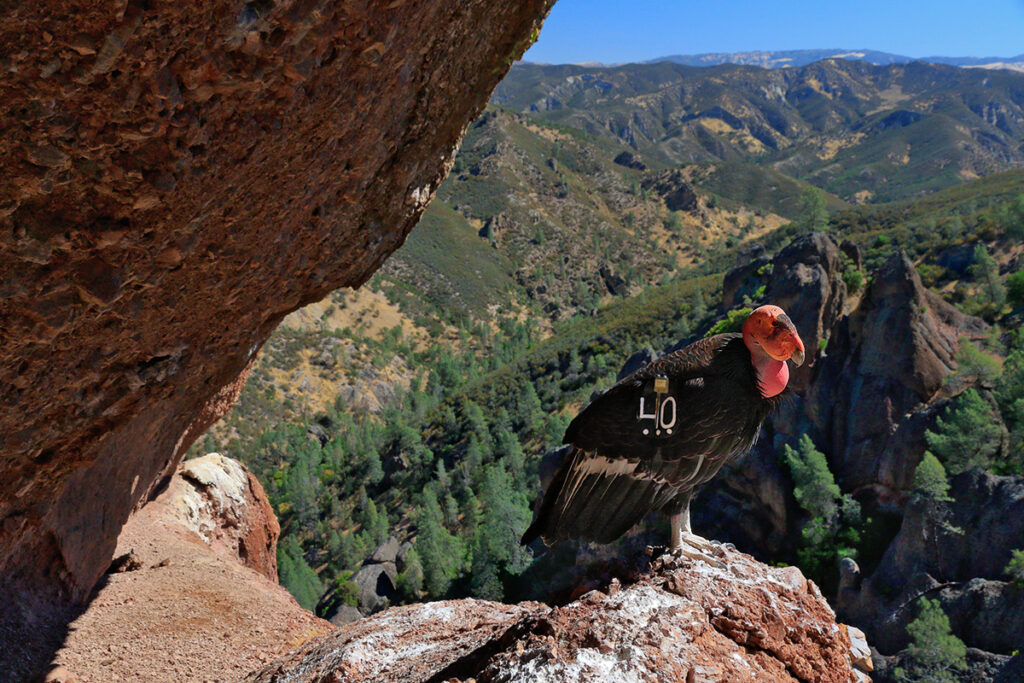
Grand Canyon National Park, Arizona
Grand Canyon National Park is a spectacular canyon that is a perfect place for California Condors to soar. The birds are regularly seen flying along the canyon walls. Sometimes visitors get an unclose look at the birds when they roost canyon edges near the popular overlooks. Grand Canyon has proven to be a favorite nesting site with 5 different breeding pairs having successfully nested within park boundaries.
There are about 90-100 condors in the Arizona and Utah flock. These are condors that are fairly regularly seen soaring along the canyon rim.
Best Places to See California Condors in Grand Canyon National Park: Good places to look for condors is along Bright Angel Trail, Yaki Point, Yavapai Point, and Lookout Studio. Sometimes they are seen roosting on the railing.
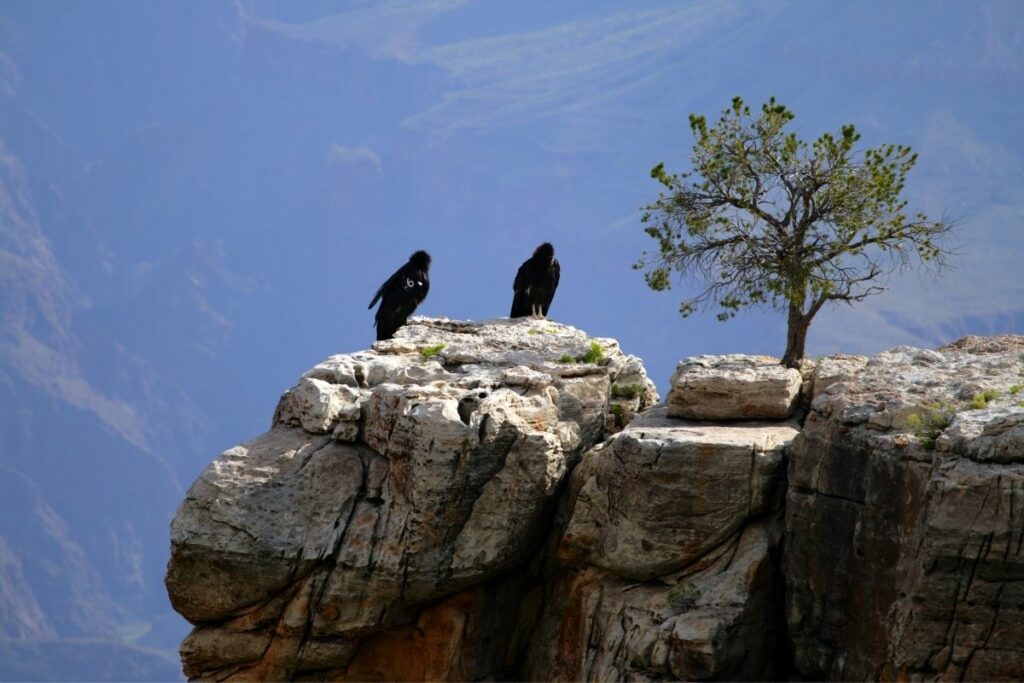
Zion National Park, Utah
Zion National Park is slowly becoming a favorite spot for California condors. In 2019, #409 and #523 chose the spectacular Angel’s Landing as their nesting site. Their chick #1000 was a milestone chick. He was the 1000 chick born as part of the recovery plan and the first chick born in Zion in over 100 years. There are about 90-100 condors in the Arizona and Utah flock. These are condors that are fairly regularly seen soaring above Zion canyon with #1000 (wing tag is black and has 1K on it) is seen often.
Best places to see California Condors in Zion National Park: Good places to look for condors are along Angels Landing, Observation Point, and anywhere under a condor closure.
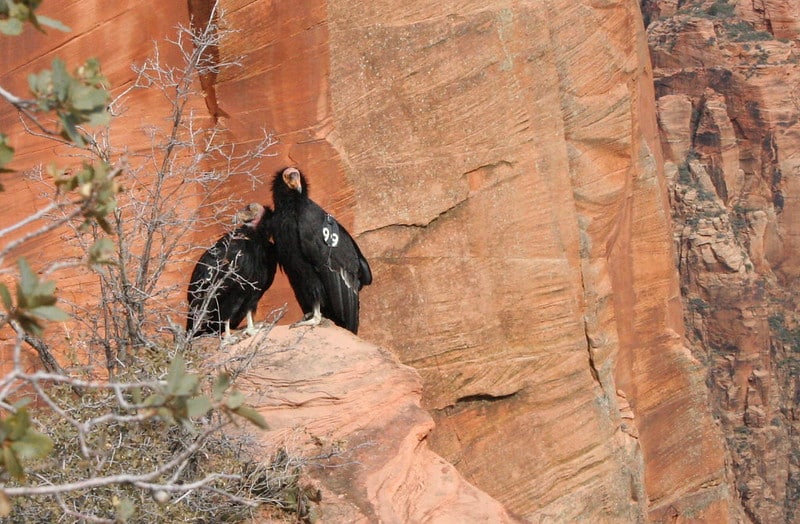
Redwoods National Park, California
Redwoods National Park will be the newest release site for California condors. The first releases are planned for 2021 or 2022 pending final preparations.
Best places to see California Condors in Redwoods National Park: It is likely that some of the released birds will stay in the area and be regularly see nesting and roosting in the tall redwood trees.
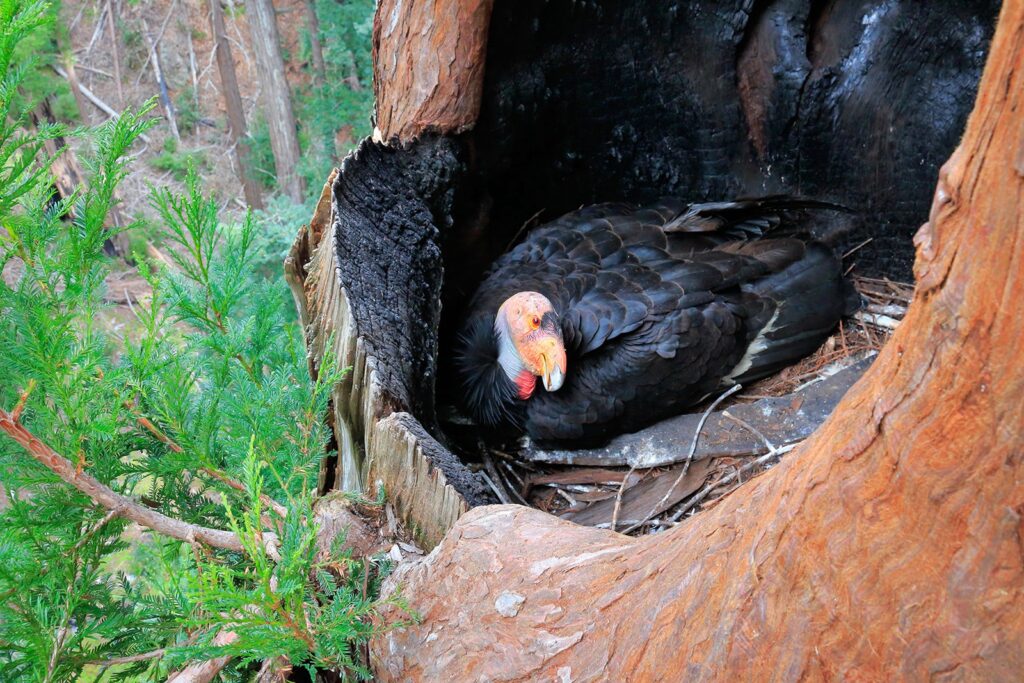
Sierra de San Pedro Mártir National Park, Baja California, Mexico
Sierra de San Pedro Mártir National Park is the Mexico release site for the California Condors.
There are about 30-40 condors in the Baja flock.
Best places to see California Condors in Sierra de San Pedro Mártir National Park: Just before the park entrance is a lookout where the condors like to congregate but they are seen soaring over much of the park.
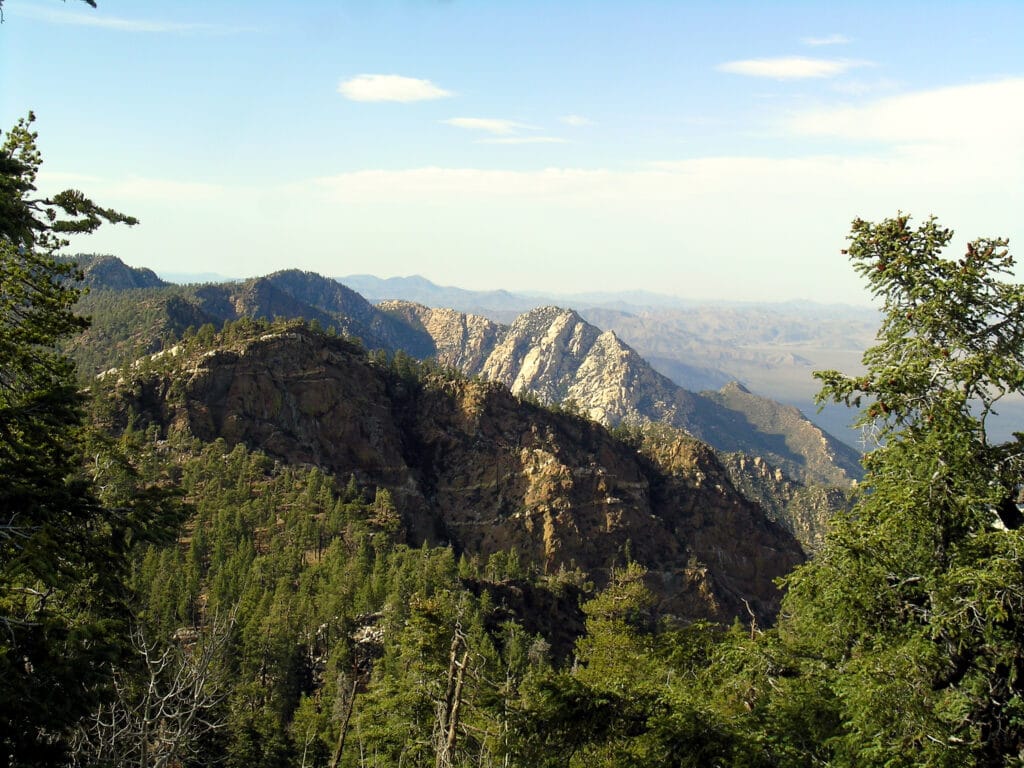
Other National Parks where California Condors have been sighted
These are National Parks within the Condors’ known range. It is worthwhile to keep an eye out when visiting these parks but sightings are currently rare.
Other Places to see California Condors
Big Sur, California
Big Sur is one of the best places to view California Condors. The area is home to the Ventana Wildlife Society condor research facility and release site infrastructure is one of the release sites for the California Condors. The facility and release site burned in 2020 but there are plans to rebuild.
Big Sur has a residential flock of condors that ranges between 20-30 individuals. These condors are often seen soaring along the Pacific Coast Highway.
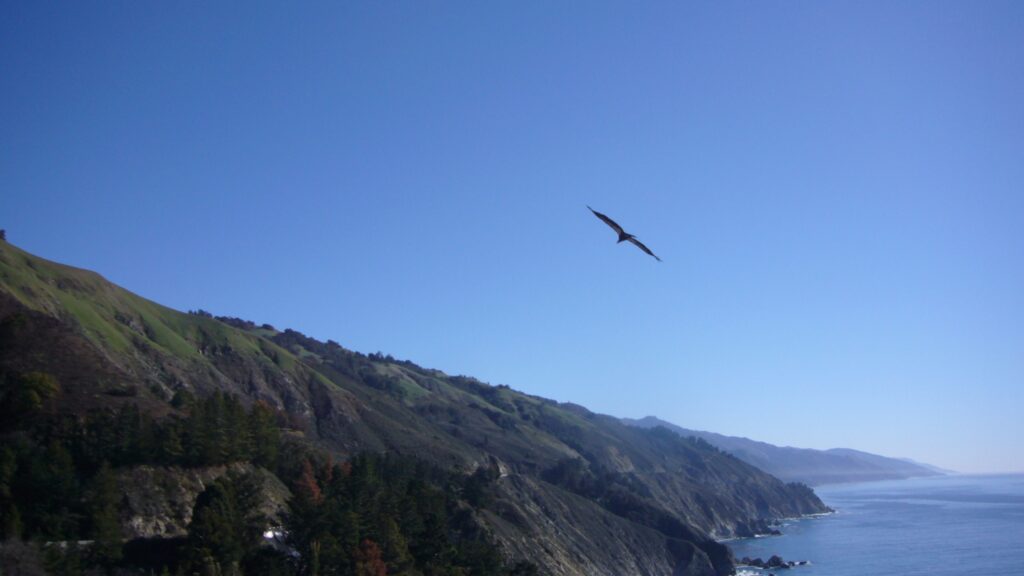
Bitter Creek National Wildlife Refuge, California
Bitter Creek National Wildlife Refuge was the refuge of the last remaining wild condors. In 1986, the last wild condors were capture here and taken into the captive breeding program. The refuge is located at the nexus of two east/west mountain ranges and provides an important movement corridor between native wildlife populations. Much of Bitter Creek was purchased to protect California Condor foraging and roosting habitats.

Cedar Breaks National Monument, Utah
Cedar Breaks National Monument is a natural amphitheater that is about 3 miles across and over 2,000 ft deep. Several California Condors have started to spend time in the area and are often see roosting on the amphitheater rim or soaring above.
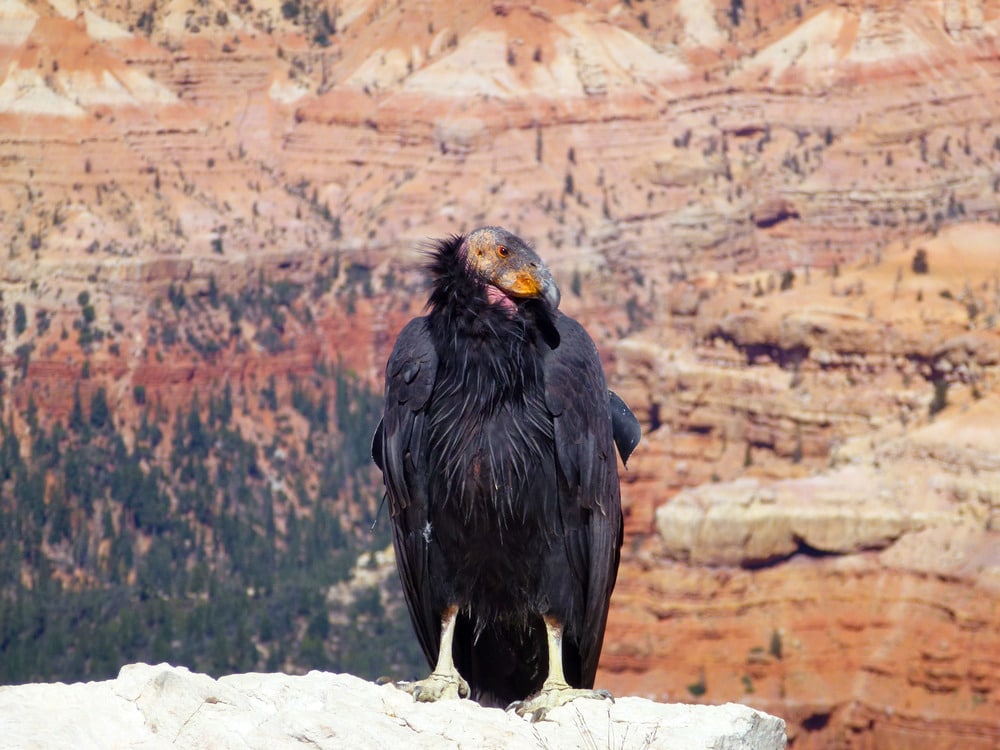
Los Padres National Forest, California
Los Padres National Forest is considered to be the “Home of the California Condor.” In 1947, the Sespe Condor Sanctuary was established within the forest. Access to the sanctuary is limited to four recreation travel corridors of the Sespe Creek, Agua Blanca Creek, Alder Creek, and Bucksnort Trails.
The Los Padres Condor Range and River Protection Act of 1992 was passed to help control public access to the Sanctuary as well as to protect condor nesting, roosting, and foraging habitat. The act also established the Sespe Wilderneess to further protect the birds from development and human activity.
There are 103 residential Californiana Condors in Los Padres National Forest.
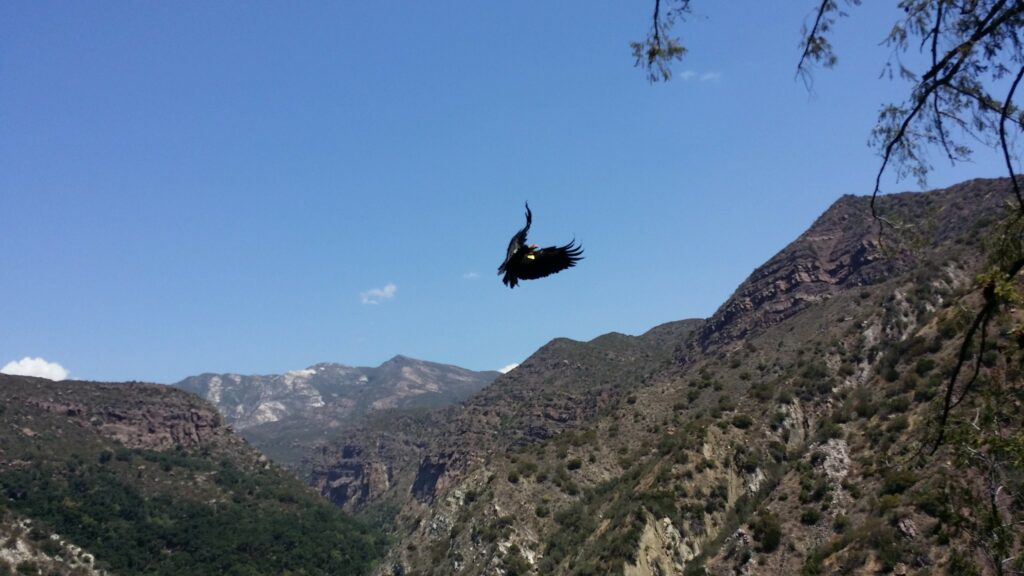
Kaibab National Forest, Arizona
Kaibab National Forest shares its condor population with Grand Canyon National Park. Radio tracking shows that the California Condors spend a lot of time on the Kaibab Plateau in the North Kaibab Ranger District. In 2019, two pairs of condors successfully nested in the forest.
Vermilion Cliffs National Monument, Arizona
Vermilion Cliffs National Monument is a Bureau of Land Management National Monuments. The area is one of the release sites for the condors in Arizona. The California Condors can be found roosting at the top fo Vermillion Cliffs. Viewing is best done with bincoulars or a spotting scopes. Mated pair #266 and #296 have successfully nested within the monument 3 times and #114 has successfully nested twice with two different partners.
Glen Canyon National Recreation Area, Arizona / Utah
Glen Canyon National Recreation Area is near Vermillion Cliffs and newly released birds often head towards Glen Canyon. The residential condors are often seen along the dam. In 2018, #354 and #496 successfully fledge the first Glen Canyon California Condor chick.

Final Thoughts on the Best National Parks to see California Condors
I hope you found this guide to where to see California Condors helpful. Please let share any condor sighting in the comments below.
Check out our other wildlife viewing guides
Pin for later: Best National Parks to see California Condors

Jennifer Melroy
Hi, I'm Jennifer!

Welcome to the wonderful world of National Parks. I'm here to help you plan your NEXT amazing adventure through the United States National Parks and beyond. I want the national parks to be accessible to all.
I live in Tennessee, and when I'm home, you can find me hiking in the Smokies and the Cumberland Plateau.
58/63 National Parks
250+/423 National Park Units
Want to know more? Start Here.
ACKNOWLEDGEMENT OF LAND
On this site, we promote travel to the United States and beyond that are the traditional lands of Indigenous and First Nations peoples.
With respect, I make a formal land acknowledgment, extending my appreciation and respect to these lands’ past and present people.
To learn more about the people who call these lands home, I invite you to explore Native Land.
DISCLAIMER
National Park Obsessed assumes no responsibility or liability for any errors or omissions in the content of this site (NationalParkObsessed.com). The information contained in this site is provided with no guarantees of completeness, accuracy, usefulness or timeliness. You are encouraged to conduct your own due diligence before acting on the information provided on this site and should not rely on the opinions expressed here.
There is an inherent risk in all outdoor recreation activities, the reader assumes all responsibility for their own personal safety.
DISCLOSURE
We are a participant in the Amazon Services LLC Associates Program, an affiliate program designed to provide a means for us to earn fees by linking to Amazon.com and affiliated sites.
Privacy Policy • About Us • Contact
Select stock photography provided depositphotos
Copyright ©2023 National Park Obsessed, LLC
Last Updated on 20 Aug 2022 by Jennifer Melroy



